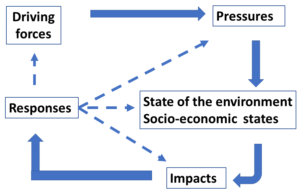DPSIR (Drivers, Pressures, States, Impacts, Responses)

DPSIR (Drivers, Pressures, States, Impacts, responses) is a framework in which you can look at and analyse the important and interlinked relationship between social and environmental factors. It is a well received popular framework internationally. The DPSIR model is a good analytical framework for assessing complex natural resource issues. For example, because fresh water management looks at continuously fluctuating complex aquatic ecosystems and the its relationship to surrounding populations, it is useful to be able to examine – the state of, and impacts on – these ecosystems, not just in the present but also through time.
Using a DPSIR framework to support good natural resource management and policy
A DPSIR framework highlights the key relationships between society and the environment, and can be used as a communication tool between researchers from different disciplines (social and natural) as well as between researchers, on the one hand, and policy makers and stakeholders on the other. This 2022 LfS post provides an introduction to an extended DPSIR framework, and looks to show how this can be used to more closely link the social and natural sciences to help policy makers address complex problem situations. It also offers some pointers to how the framework can be used to develop just and equitable transitions.
Re-imagining the driver–pressure–state–impact–response framework from an equity and inclusive development perspective
Gupta, Joyeeta, et al. Sustainability Science 15.2 (2020): 503-520.
The Driver–Pressure–State–Impact–Response (DPSIR) framework has been used by environmental agencies and others to assess environmental challenges and policy responses. However, in doing so, social justice or equity issues tend to come as an afterthought, while there is evidence that environmental challenges and policy responses are not equity (including gender-) neutral. Hence, this paper addresses the question: why should, and how can, equity issues and environmental justice be incorporated into the DPSIR framework? It presents a structure for including equity within DPSIR and applies it. It reviews the literature to bring together data that demonstrates that there is a clear equity perspective along the entire DPSIR analysis. It concludes that although individual environmental policies may succeed to achieve their specific goal in the short term; if they ignore the equity aspects, the policy strategies as a whole are likely to be environmentally unjust, and lead to exclusive and unsustainable development, which, in turn, could further exacerbate environmental challenges. This highlights the need for an integrated approach in efforts to achieve environmentally sustainable development.
From the DPSIR, the D(A)PSI(W)R(M) emerges… a butterfly – ‘protecting the natural stuff and delivering the human stuff’
Ecosystem-Based Management, Ecosystem Services and Aquatic Biodiversity. Springer, 2020. pp. 61-86.
In this chapter by Michael Elliott and Timothy O’Higgins show how the Driver Pressure State Impact Response (DPSIR) conceptual framework can be adapted and re-developed to become the D(A)PSI(W)R(M). They describe the model in detail, and outline the reasons for its development from the original DPSIR conceptual frame. Thew authors’ also present a derived framework, the “Butterfly”, a more holistic approach designed to expand the concept for the assessment and design of Ecosystem-Based Management. The “Butterfly” model, moves away from the centralised accounting framework approach while more-fully incorporating the complexity of social and ecological systems, and the supply and demand of ecosystem services, which are central to human-environment interactions. There are lots of other insightful and interesting chapters in this open e-book as well.
DPSIR—Two Decades of Trying to Develop a Unifying Framework for Marine Environmental Management?
Frontiers. Mar. Sci. 3:177
Determining and assessing the links between human pressures and state-changes in marine and coastal ecosystems remains a challenge. Although there are several conceptual frameworks for describing these links, the Drivers-Pressures-State change-Impact-Response (DPSIR) framework has been widely adopted. This 2016 paper by Joana Patricio and colleagues begins to highlight the indicators which are needed to enable feedback on the resulting impact of current and future policy choices. Challenges in use primarily relate to the long standing variation in interpretation (mainly between natural and social scientists) of the different components (particularly P, S, and I) and to over-simplification of environmental problems such that cause-effect relationships cannot be adequately understood by treating the different DPSIR components as being mutually exclusive. More complex, nested, conceptual models and models with improved clarity are required to deal with wicked problems. We emphasize the value of merging natural and social sciences and in showing similarities across human and natural environmental health. The authors show that previous approaches have adequately given conceptual and generic models but note that specificity and quantification is required.
How the DPSIR framework can be used for structuring problems and facilitating empirical research in coastal systems
Environmental Science & Policy, 2016, Elsevier, vol. 56, pages 110-119
This paper by Rebecca L. Lewison and colleagues points out that although the application of the DPSIR framework has considerable potential to bridge the gap between scientific disciplines and link science to coastal policy and management, current applications of DPSIR in coastal environments have been limited and new innovations in the application of the DPSIR model are needed. We conducted a structured review of literature on the DPSIR framework as applied to the function, process and components of complex coastal systems. The authors’ specific focus was on how the DPSIR framework has been used as a tool to organize sophisticated empirical scientific research, support transdisciplinary knowledge at a level appropriate for building understanding about coastal systems, and how adopting a DPSIR approach can help stakeholders to articulate and structure challenges in coastal systems and use the framework to support policy and management outcomes. The review revealed that DPSIR models of coastal systems have been largely used to support and develop conceptual understanding of coastal social–ecological systems and to identify drivers and pressures in the coastal realm. However, only in eight of 24 shortlisted articles did researchers actively engage decision-makers or citizens in their research: given the potential opportunity for using DPSIR as a tool to successfully engage policy-makers and stakeholders, it appears that the DPSIR framework has been under-utilized in this regard.
Effective indicators for freshwater management: attributes and frameworks for development
This 2012 report by Will Allen and colleagues is a useful resource for getting ideas for identifying and selecting appropriate indicators. And is an introduction to how indicators can be used in catchment land and water management. It also goes over nicely two common frameworks used in environmental Management and Evaluation systems, Programme-based models and the Pressure-State-Response approaches.
Environmental indicators: Typology and overview
Here is a report that looks at what EEA uses in its reporting activities, both the EEA ’Typology of indicators’ and the DPSIR framework. It tries to help define common standards for future indicator reports. Their aim of the report was also to help policy-makers to understand the meaning of the information in indicator reports.
Applying DPSIR to sustainable development
Have a look at some problems and challenges people are finding with an approach such as DPSIR to the goal of sustainable development. The authors in this paper look at the lack of aggregated impacts of local, informal responses on drivers, pressures and states.
How the DPSIR framework can be used for structuring problems and facilitating empirical research in coastal systems
Here is a “structured review of literature on the DPSIR framework as applied to the function, process and components of complex coastal systems”.
Using the DPSIR framework for transdisciplinary training and knowledge elicitation in the Gulf of Thailand
Have a look at a cross-border, socio-ecological systems case study in Thailand and Cambodia. It looks at the suitability of DPSIR as a tool for analysis and communication, how it can promote discussion.
Drivers and pressures: Untangling the terms commonly used in marine science and policy
As identified in some of the resources above, there is a need to have a set upon and unified definitions within the frameworks on a global leave. For better communication between science and management and the international community. This article puts forward definitions compatible with the DPSIR within a marine focus.
 | Michael Allen [Email: [email protected] - LinkedIn: Michael Allen] I am a hydrogeologist and environmental scientist, with a focus on data science and environmental assessments. I have developed strong research, analytical and technical skills through multiple projects and my recent Masters in Groundwater and Global Change from IHE Delft. I have a particular interest in environmental protection and remote sensing. |